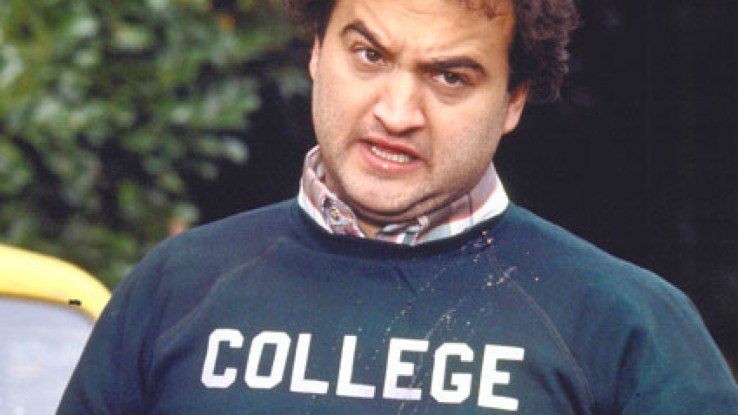With emerging last-mile training programs, is college necessary?

My 11-year-old son Leo has a strange new obsession: the state of Connecticut. It started with a school project but has evolved to ordering Connecticut license plates online, a new favorite baseball team (the minor league Hartford Yard Goats — Go Goats!) and a new hobby: writing Wikipedia entries on Connecticut topics.
His first Wikipedia entries were obscure Connecticut state roads (Routes 539, 607 and, of course, 664, among others). He also did one on the new Earth Tower of the Mohegan Sun Casino. Subsequently, as a result of the fact that his Wikipedia overlords wouldn’t let him post photos of the Earth Tower that he hadn’t taken himself, Leo insisted on: (1) an explanation of the concept of copyright; and (2) changing our summer travel plans to include a 3-day tour of Connecticut, featuring an overnight at Mohegan Sun.
I didn’t mind too much because I thought it might remind me of my college years in Connecticut. Because, despite what regular readers might conclude from the various absurd college stories I’ve shared, I’ve actually forgotten much of what went on there — certainly most non-absurd things.
Over the past few months, I’ve begun to outline the idea of last-mile training: the combination of technical education and placement services that has the potential to fill the skills gap across many sectors of the economy.
In addition to coding, University Ventures has already made investments in last-mile training providers in sales, medical devices and insurance. I’ve also suggested that last-mile providers are evolving to become college “minimum viable products” or feasible substitutes to traditional higher education. As a result, I’ve received a number of inquiries that boil down to something like this: What will we lose if the last mile becomes the only mile?
As last-mile providers are emerging as a direct result of market forces, the first objection is fittingly economic in nature: Because millennials may change jobs as many as four times in their first decade in the workforce, isn’t it irresponsible to “train” young people for just one job? Only a broad education — not technical training — can equip students for change.

As far as I can tell, this view is nearly universally held. But there are two reasons to believe it may be wrong.
First, there may not be an unbridgeable distance in cognitive and non-cognitive skill development between last-mile programs and the average college degree. College students continue to flee the cognitive skill-building humanities for pre-professional degrees in business, accounting and a plethora of health and IT majors.
According to newly released IPEDS data, English majors now account for only 1.3 percent of all BAs, down 50 percent in the past 15 years. History majors were 1.3 percent only 10 years ago, but are now only 0.7 percent. At the same time, most last-mile programs claim to develop a wide range of cognitive and non-cognitive skills, albeit in a shorter time frame.
Holberton School says its project-based learning curriculum fosters “improved communication and interpersonal/social skills, enhanced leadership skills, and increased creativity.” Make School’s “Product College” explicitly develops problem solving and communication skills.
As for the second reason, while the opposite of education is lack of education (I’ve discussed this in the context of last year’s election), in a more personally relevant sense for most readers, the opposite of education — of gaining knowledge and skills — is forgetting.

In June, the MIT Center for Brains, Minds + Machines released a working paper by Brian Subirana, Aikaterini Bagiati and Sanjay Sarma titled On the Forgetting of College Academics: At “Ebbinghaus Speed”?
The MIT researchers surveyed the scientific literature and concluded there is no evidence that anything significant and “unused” is remembered beyond two years. The “Universal Law of Forgetting,” said the researchers, is that content knowledge that is not refreshed decays according to the Ebbinghaus Curve.
Hermann Ebbinghaus was a 19th century German psychologist who pioneered the study of memory. In 1885, around the same time neurons were discovered, he published “On Memory,” which revealed the “Forgetting Curve,” where knowledge decays according to the formula R = e –(t/s), where R is retention, s is the relative strength of memory and t is time. According to the MIT researchers, the upshot — consistently reproduced across hundreds of experiments — is that we lose 50 percent of unrefreshed content knowledge every two years.
In a recent presentation at MIT, Subirana was critical about the structure of traditional higher education, hypothesizing that “what we learn in the classroom is irrelevant for students in the long run” unless they re-use it soon and often.
Subirana acknowledges that nearly all the research on this topic concerns content knowledge and not skills. And there are obvious examples of unrefreshed retention beyond two years, such as facial recognition or motor skills like riding a bicycle. So the key question for higher education is whether critical thinking, problem solving and the other core cognitive skills that college aims to inculcate are more like content knowledge or more like riding a bike.
In his presentation, Subirana and a colleague discuss another MIT paper from 2009: “What do Seniors Remember from Freshman Physics.” In the study, seniors are surprised with a request to re-take a physics exam they took freshman year. Those who hadn’t continued in physics or a physics-related field achieved at approximately half the level of 3.5 years earlier. Only those who went on to major in physics, mechanical engineering and aeronautics/astronautics did as well or better.
While a freshman physics exam is primarily about content knowledge, performance on such a test isn’t completely unrelated to cognitive skill development. Subirana surmises that unused cognitive skills are not exempt from Ebbinghaus’ curve. “Forgetting is unavoidable,” he says. In the paper, he and his colleagues speculate that “the brain may behave a bit like regular physical muscles and practice may increase their ability.”
In a general sense, every graduate practices the cognitive and non-cognitive muscles flexed in college. College improves problem solving and critical thinking abilities. Graduates enter the workforce and encounter problems that must be solved. But Subirana’s work points toward much greater specificity: The closer the practice to the original skill “memory,” the more likely the skill will be retained.
If our goal is to increase society’s store of skills, we must mount a vigorous defense to the tyranny of Ebbinghaus’ curve. The most effective defense is to link practice of skills in the workforce as closely as possible to the context in which they were learned. Unfortunately for higher education, the mountain (work) will not come to Muhammad (higher education). So Muhammad must go to the mountain.
This means that if a student’s first job is going to be in mobile UX/UI design, they’ll be more likely to retain and deepen cognitive and non-cognitive skills developed in formal postsecondary education if they were inculcated as part of a mobile UX/UI design program.
And as this is exactly the point of last-mile training, there’s reason to believe Student A’s retention of cognitive and non-cognitive skills following a last-mile training program plus two years’ work experience as a mobile UX/UI designer may rival or exceed Student B who earns an unrelated bachelor’s degree and then (miraculously is hired and) works for two years in the same job.
There’s nonetheless an obvious risk that while cognitive and non-cognitive skills developed by last-mile training (and retained through closely connected work) may end up being deep, they may not be broad. Tennyson famously said “Ring out the old, ring in the new… Ring out the false, ring in the true.”

We need to make sure that as last-mile programs and college MVPs proliferate, we’re not simultaneously ringing in the false and ringing out the true. In other words, even if these new pathways help millions of our economically disenfranchised and disgruntled brothers and sisters join the vibrant American economy, will we find we’re all more susceptible to fake news because unable to critically engage with information we find on Facebook? Or not unimportant, will anyone know who the heck Tennyson was? This is something that keeps me up at night.
Nevertheless, the study of forgetting isn’t educational nihilism. It’s instructive for determining how best to deploy the hundreds of billions of dollars that are currently flowing overwhelmingly to a single model of higher education. And it indicates that if we begin to diversify, we may lose less than we fear.
Leo and I had a great time in Connecticut. We went to a Yard Goats game. We stayed at the Mohegan Sun so he could take his photos. And we enjoyed the world’s greatest pizza: Pepe’s in New Haven. Although Leo had prepared a detailed itinerary down to the hour, I prevailed upon him to walk around New Haven for 90 minutes. I managed to show him a few important places, and pleasant memories flooded back.
People often ask me whether Leo and his brothers will go to college. My answer is: It’s entirely up to him. As long as he’s in an environment — study or work — where he’s learning from his peers, I’ll be supportive of that. And if that’s a last-mile training program or college MVP, I’m confident he’ll find his own Connecticut, and probably remember it much better.